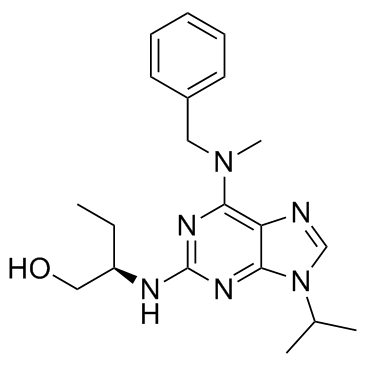866893-90-5
| Name | 1-Butanol, 2-[[9-(1-methylethyl)-6-[methyl(phenylmethyl)amino]-9H-purin-2-yl]amino]-, (2R) |
|---|---|
| Synonyms |
Aftin 4
Aftin-4 |
| Description | Aftin-4 is an Amyloid-β42 (Aβ42) inducer. |
|---|---|
| Related Catalog | |
| Target |
Amyloid-β[1] |
| In Vitro | Aftin-4 selectively and potently increases Aβ1-42 in N2a cells, primary neurons, and brain lysates, with an EC50 value around 30 μM[1]. |
| In Vivo | Aftin-4 increases Aβ1-42 levels in vivo in mice and provokes rapidly a sustained toxicity highly reminiscent of Alzheimer’s disease (AD). Aftin-4 is administered at increasing doses, between 3 and 20 nmol/mouse, into the lateral ventricle and animals are sacrificed at various time points, between 3 to 14 days after injection. The hippocampus is dissected out the contents in Aβ1-40 or Aβ1-42 is determined using a mouse ELISA assay. Aftin-4 dose-dependently and significantly increases Aβ1-42 content, up to +216% at the highest dose tested[1]. |
| Animal Admin | Mice[1] Male Swiss OF-1 mice, aged 7-9 weeks and weighing 32±2 g are used. Aftin-4 is solubilized in DMSO at a concentration of 3 mg/mL and stored at -20°C until use. Aftin-4 is administered intracerebroventricularly (i.c.v. ), with a Hamilton microsyringe equipped with a 3-mm needle in a final volume of 3 μL per mouse. The injection coordinates are -0.4 mm with respect to bregma, 1.00mm to the right from the central, and 2.50mm in depth. Aftin-4 is also injected intraperitoneally (i.p.). Aftin-4 is solubilized in DMSO 40% in distilled water at 2, 6 or 20 mg/mL and administered in a final volume of 100 μL/20 g body weight[1]. |
| References |
| Molecular Formula | C20H28N6O |
|---|---|
| Molecular Weight | 368.47600 |
| Exact Mass | 368.23200 |
| PSA | 79.10000 |
| LogP | 3.29940 |
